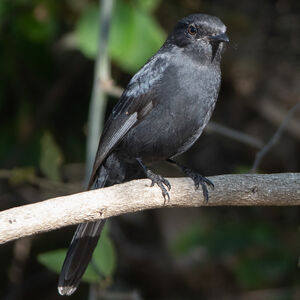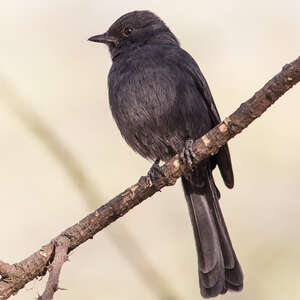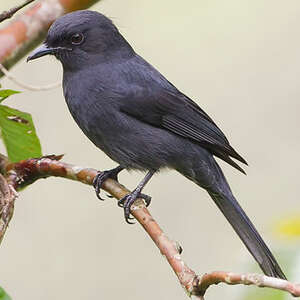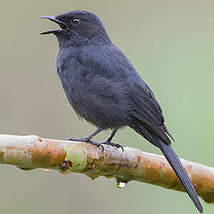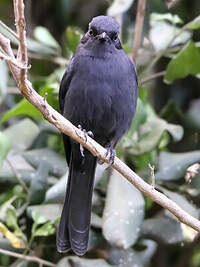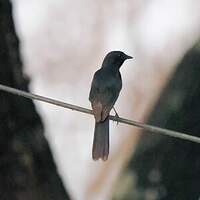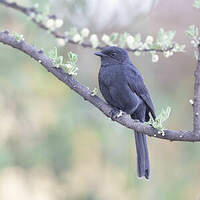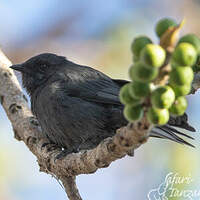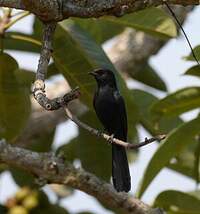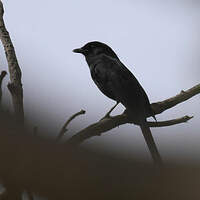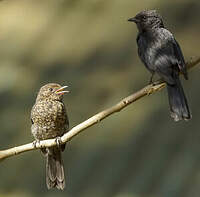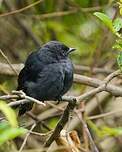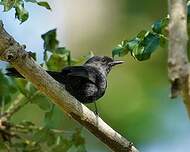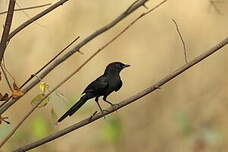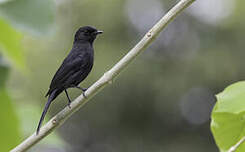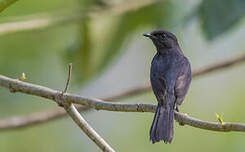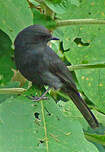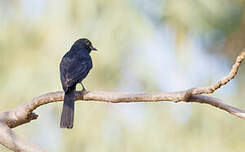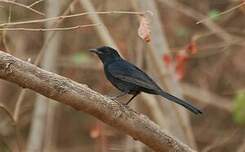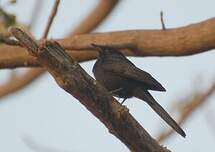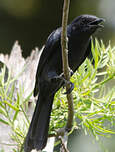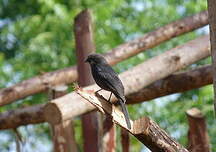Northern Black Flycatcher
Melaenornis edolioides - Gobemouche drongo
Identification
The Northern Black Flycatcher is one of the largest species of flycatcher. Like all members of its genus, it has a long tail complemented by short wings. From a distance, it looks like a small blackbird since it appears to be mostly black. In reality, it is slate gray with a clearly bluish tinge under proper light conditions for the male of the type subspecies. The lores and parotids are blackish. Its wings and tail are even darker, with hints of brown-black, edged with grayish-blue and with a slightly barred pattern. The iris is brown-dark brown. The black beak is strong and surrounded by vibrissae, and the upper mandible is slightly overhanging. The legs are black.
The female is duller than the male, with upperparts being blackish gray and the underparts being paler gray. The juveniles are completely spotted and streaked with rusty ocher, with the exception of the flight feathers. Their beaks and legs are brown. The immature resembles the female though its wings and tails are browner.
Melaenornis edolioides lugubris is slightly duller.
Melaenornis edolioides schistaceus is grayer.
The squared ending of the tail and the size of its beak distinguish this species from the two other long-tailed insectivore species, the Shining Drongo and the Ludwig's Drongo, which inhabit similar biotopes.
Subspecific information 3 subspecies
- Melaenornis edolioides edolioides (s Mauritania, Senegal and Gambia to w Cameroon)
- Melaenornis edolioides lugubris (e Cameroon to Eritrea, w Ethiopia, w Kenya and n Tanzania)
- Melaenornis edolioides schistaceus (n and e Ethiopia, n Kenya)
Foreign names
- Gobemouche drongo,
- Papamoscas drongo,
- papa-moscas-preto-setentrional,
- Senegaldrongoschnäpper,
- Senegalese Drongovliegenvanger,
- Pigliamosche nero settentrionale,
- svart flugsnappare,
- Svartfluesnapper,
- muchár sadzový,
- lejsek černý,
- Sort Fluesnapper,
- mustasieppo,
- papamosques negre septentrional,
- mucharka czarna,
- Северная чёрная мухоловка,
- クロヒタキ,
- 黑鹟,
- 北方黑鶲,
Voice song and cries
Ordinarily quiet, the Northern Black Flycatcher expresses itself by making calls that can be translated as such: its contact call is a long tseeeeu or a short tsik. Its alarm call is a deep and sharp kchchew. It becomes more vocal during the breeding season. Its song, rather melodious, is made of short sentences interspersed with small pauses: tsee-u-weet, tuwee-teewiteewi, yewee-teedudit, ptee-yay, tsee-ew, all repeated for a long time. Both the male and the female can sing in duet.
Habitat
The Northern Black Flycatcher lives in humid forests, riparian forests and gallery forests, acacia savanna, shrubby savanna, plantations and other cultivated areas with trees. It can also be found in more arid areas, such as around Lake Turkana in Kenya, and can climb up to 1,800 meters of altitude.
Behaviour character trait
The Northern Black Flycatcher lives alone or in pairs. Even though it is quite solitary, it often hunts in small, single- or multi-species groups, which facilitates the discovery of food sources. It looks for its prey on the ground, either directly or from a low branch. It can also catch them in flight, or on branches and leaves.
Dietfeeding habits
Reproduction nesting
The breeding season for the Northern Black Flycatcher corresponds to the local rainy seasons. This species is monogamous and very territorial.
The nest, usually hidden in a dead tree fork and placed between two and six meters from the ground, is a rough and shallow cup made of twigs, dry grass and bark. A thin layer of rootlets and fibers line the cup. A tangle of banana clusters or palm leaves can, if necessary, provide an anchor for the nest. The pair may also use old nests of other species. The female lays two to three eggs and incubates alone for 13 to 16 days. Both sexes then feed the chicks which leave the nest 15 to 20 days after hatching.Geographic range
The Northern Black Flycatcher is a resident of tropical Africa. It lives from Senegal to Sudan and Ethiopia along a continuous belt reaching the Gulf of Guinea in Ghana. The southern limit runs from Cameroon to the extreme north of Tanzania east of Lake Victoria, the only place in the range south of the equator. There is little or no movement for this species. The only movements known to it would be related to the rainy season in Kenya.
Threats - protection
IUCN conservation status
concern
in the Wild
threatened
evaluated
The Northern Black Flycatcher is rare to frequent depending on locations. It is generally not threatened. No information is currently available about the evolution of its population or the potential threats it faces, but it seems its numbers are stable.
Sources of information
- IOC World Bird List (v14.1), Gill, F and D Donsker (Eds). 2024-04-18.
- BirdLife International, BirdLife International
- HBW Alive,
- Biodiversity explorer The web of life in Southern Africa,
- Birds of East Africa: Kenya, Tanzania, Uganda, Rwanda, Burundi, Terry Stevenson, John Fanshawe
Other sources of interest
 Specification sheet created on
23/07/2023 by Nathalie Santa Maria
Specification sheet created on
23/07/2023 by Nathalie Santa MariaTranslation by AI Oiseaux.net
published: 04-02-2017 - Updated: 10-02-2017
© 1996-2024 Oiseaux.net
- Accipitriformes
- Aegotheliformes
- Anseriformes
- Apodiformes
- Apterygiformes
- Bucerotiformes
- Caprimulgiformes
- Cariamiformes
- Casuariiformes
- Charadriiformes
- Ciconiiformes
- Coliiformes
- Columbiformes
- Coraciiformes
- Cuculiformes
- Eurypygiformes
- Falconiformes
- Galliformes
- Gaviiformes
- Gruiformes
- Leptosomiformes
- Mesitornithiformes
- Musophagiformes
- Nyctibiiformes
- Opisthocomiformes
- Otidiformes
- Passeriformes
- Pelecaniformes
- Phaethontiformes
- Phoenicopteriformes
- Piciformes
- Podargiformes
- Podicipediformes
- Procellariiformes
- Psittaciformes
- Pterocliformes
- Rheiformes
- Sphenisciformes
- Steatornithiformes
- Strigiformes
- Struthioniformes
- Suliformes
- Tinamiformes
- Trogoniformes

